In a speech to the Norfolk Biodiversity Partnership in 2009, visionary writer Jay Griffiths extolled ‘that lovely heart-slipping moment when you suddenly realise that you are with a knower of the land, who keeps like treasure their stanza of the song.’
Reading Language of the Land — a new anthology by the Cley-based writers’ group led by Jonathan Ward — I am often reminded of Jay’s words. For its contributors — like the wave-washed pebbles of Cley beach — are, in their diversity, united by Cley’s cycles of change. Through their shared, repeated walks and words, they have been rendered knowers.
Inevitably, in an endeavour built on common creative practice, some themes recur in the words of multiple writers. One such is the power nature exerts on us, for good. ‘We came to be unboundaried,’ writes Sue Burge, ‘unmoored; to be sculpted by wind.’ Unquestionably this is the reason so many of us revisit, time and again, Cley’s marsh and shore. To be, in Sue’s words, ‘hollowed out, refuelled.’
Close and respectful observation of wild beings is a recurrent theme too. ‘Is it improper,’ asks Tina Green, ‘to stare at beautiful / Creatures through a screen?’ But stare we must, as the dignity of our wild fellows demands it, be they Peter Lloyd’s banded agrion (‘My second life this / Short, bright’), or Chris Tassell’s kestrel (‘which joined us to show how to master the wind’), or even Lesley Mason’s oak, whom she asks to tell her ‘of the games you played in your acorn days, / your sapling courtship hidden in the woods.’
Impermanence is another of the themes woven through the work of several contributors. Barb Shannon wistfully observes, ‘all I hold dear... beautiful even / is merely a trick / of light.’ And Maddie McMahon urges us to look with compassion and attention on an autumn leaf, ‘before she is gone.’
In a book about a place so intimately connected with Norfolk Wildlife Trust, whose profits will generously be donated to support our work, the theme of impermanence inherently translates into our human ravages on the landscape too. Since, 99 years ago, Cley Marshes came into our care, huge wildlife losses have been endured — and closely documented — across the UK, not least in Norfolk.
In this vein, Barb Shannon explores what ecologists now term shifting baseline syndrome, highlighting our unreasonable delight ‘with struggling scraps / pushed to the margins / in trampled muddied corners.’ More starkly still, Cornel Howells pleads: ‘If we wish to rescue the natural world from a catastrophe of our own making, then the time for fine words and wildlife initiatives is past. The human race needs to radically reduce its global footprint and start now.’
‘We gather to share our thoughts,’ writes Barbara Stackwood of the group’s meetings through the year. Language of the Land is a work of common purpose, through kindred experience of a precious place. This purpose is to present, yes, the beauty of the natural world. But more so still, to cry for a return to a loving, dignified human relationship with nature.
In the poem which lends its name to the book, Bob Ward writes:
Listen ... Listen ... Listen ...
for the land has many voices, dialects,
uttered by diverse agencies.
Whatever the voice,
the message stays the same:
this worn land must be cherished
for all time.

